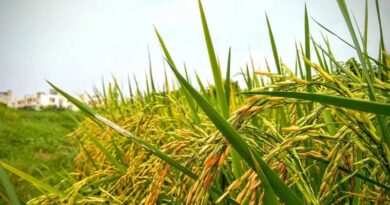The environmental challenges arising from chemical pesticide over-use
25 November 2021, UK: During the 20th century, a focus on feeding our rapidly expanding global population led farmers across the world to adopt aggressive agricultural practices – heavy machinery, monocultures and increasing volumes of chemical pesticides.
However, as these practices moved further and further away from nature, there were inevitable consequences on our soils, our air and our water supplies.
The environmental challenges arising from the over-use of chemical pesticides, in particular, have widespread implications that must be realised and addressed.
Our increasing dependency on pesticides
Since the middle of the 20th century, our use of chemical pesticides has grown steadily. Now, it is estimated that more than 1.1 billion pounds of pesticides are applied to crops every year.
It is easy to see how we have come to this situation – from 1950 to 2010, the world population increased from 2.5 billion to 6.9 billion, or by 174%. Even at the most basic level, that would mean a 174% increase in food production, with related pressures on crop yields.
Added to this, modern consumers demand ‘blemish-free fruit and vegetables, putting even more pressure on growers to eliminate pests and diseases, and average meat consumption has also increased, crop yields have needed to grow disproportionately to feed livestock.
These pressures have driven growers to apply more and more pesticides and chemicals, in a constant quest for greater yields, ‘clean’ produce, and a never-ending battle with nature as they fight pests and diseases that would undermine those efforts.
However, as well as adding toxins into our own food chains, the huge volumes of chemicals applied to our fields has led to problems for natural habitats and ecosystems.
What is the impact of pesticides on the environment?
The problem with chemical pesticides is that they eventually end up polluting the environment. Residues in our soils gradually leach through the ground to contaminate groundwater sources and waterways, while eroding soil quality (as microorganisms and earthworms vital to soil health are killed), air quality (affecting plant life) and wildlife populations.
Pesticides are designed to kill pests that would damage crops, spread disease or infect livestock. Yet they are also toxic to other living things, including non-target insects such as bees, earthworms and other beneficial soil microbes, birds, fish, mammals and humans.
In other words, chemical pesticides are frequently non-selective in their targets, and their application often risks harm to non-target organisms in our soils, air and waters.
Pollinators are the most frequently-cited example of the non-selective harm done by pesticides, but there are many others, often interrupting natural cycles of life, and exacerbating the root problems. When pesticides are applied to land or water for mosquito control, their impact reaches far beyond the target organism – often killing beneficial insects like dragonflies which eat mosquitoes and help keep other insect populations under control.
The most common type, organophosphates or OP, are neurotoxins. These pesticides have been shown to kill many species of animals, including birds, fish and amphibians. Not only do they affect the environment where they’re sprayed but also pollute our groundwater supply too.
In the past two decades, OP has emerged as a widespread contaminant in soil and water supplies, posing a significant toxicological threat to aquatic ecosystems, soil and human health
How can we reduce the impact of pesticides on the environment?
It is important to remember that not all pesticides are harmful. In fact, some pesticides help reduce the need for more toxic chemicals and can be used safely by informed individuals. However, the toxic effects of a growing number of chemical pesticides, on humans and the environment, are leading an increasing number of countries to ban these chemicals.
The Pesticide Action Network (PAN) has a searchable map that shows which states have banned the use of pesticides on lawns, gardens, childcare play areas, school grounds, golf courses/country clubs, parks and campgrounds. States with pesticide bans are shown in green and state lacking any ban or regulation are in yellow. [URL link to this]
Countries like Australia have implemented a ban on certain pesticides, but this solution has led to the overuse of others.
Therefore, it is not enough to simply ban chemical pesticides – other strategies must be employed, allow the adequate control of crop pests and diseases in a manner that does not challenge the environment, and allows us to protect our planet as well as our crops.
The solution lies in nature itself
If we take time to understand the natural cycles and relationships in agriculture, we can harness that nature to help control pests and diseases, without the intervention of toxic chemicals.
At its most simple crop rotation and mixing plant species can limit pests and prevent an infestation by removing host plants from areas in which pests and disease organism populations have grown.
By rotating crops over a period long enough to deprive those populations of food, long enough for them to die out, those pests and diseases can be controlled with no additional interventions at all.
Another strategy is to grow disease-resistant plants; breeders can utilize genetic technology to grow plants that are able to produce their own pesticides (but this also has its limitations as some pesticides like those made by wasps cannot be reproduced in such ways).
Other alternative methods harness the natural relationships between predators and prey. For example, introducing certain kinds of wasps can control pest infestations without harming other organisms or nearby wildlife. This is a traditional example of what we now refer to as ‘biopesticides’.
‘Biopesticides’ present a return to nature and the utilization of macroorganisms, microorganisms, natural plant chemicals and other biochemicals that can be used to kill or affect the physiology of crop pests and diseases. As they harness natural inter-organisms relationships, these solutions are usually highly selective for the target organism, providing effective control without affecting other beneficial insects or microbes.
Their natural origin also means that they biodegrade after use, replenishing the soil rather than polluting it. For more information about biopesticides, click here.
In conclusion
The use of pesticides may be in some cases, but we must be aware of any potential impact on the environment, and do all we can to limit those effects by making sure that they are used responsibly by farmers and manufacturers alike.
The use of chemical pesticides can be reduced – and sometimes avoided altogether – by the implementation of more sustainable solutions that are founded in nature and do not present the same toxic challenges caused by the over-use of chemical pesticides.
Bionema can help identify natural pest control solutions for horticulture, forestry, turf and amenity, and public health.
Our innovative solutions can help to reduce chemical pesticide use and protect the environment while controlling pests and diseases effectively at the same time.
Get in touch with us to discuss the solutions that would work for you.















